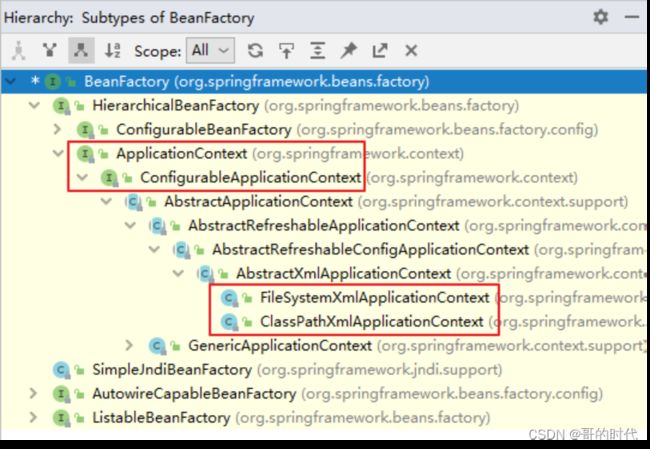Spring之容器:IOC(1)
学习的最大理由是想摆脱平庸,早一天就多一份人生的精彩;迟一天就多一天平庸的困扰。各位小伙伴,如果您:
想系统/深入学习某技术知识点…
一个人摸索学习很难坚持,想组团高效学习…
想写博客但无从下手,急需写作干货注入能量…
热爱写作,愿意让自己成为更好的人…
文章目录
- 前言
- 一、IoC容器
-
- 1、控制反转(IoC)
- 2、依赖注入
- 3、IoC容器在Spring的实现
- 二、基于XML管理Bean
-
- 1、搭建子模块spring6-ioc-xml
- 2、实验一:获取bean
-
- ①方式一:根据id获取
- ②方式二:根据类型获取
- ③方式三:根据id和类型
- ④注意的地方
- ⑤扩展知识
- 3、实验二:依赖注入之setter注入
- 4、实验三:依赖注入之构造器注入
- 5、实验四:特殊值处理
-
- ①字面量赋值
- ②null值
- ③xml实体
- ④CDATA节
- 6、实验五:为对象类型属性赋值
-
- 方式一:引用外部bean
- 方式二:内部bean
- 方式三:级联属性赋值
- 总结
前言
IoC 是 Inversion of Control 的简写,译为“控制反转”,它不是一门技术,而是一种设计思想,是一个重要的面向对象编程法则,能够指导我们如何设计出松耦合、更优良的程序。
Spring 通过 IoC 容器来管理所有 Java 对象的实例化和初始化,控制对象与对象之间的依赖关系。我们将由 IoC 容器管理的 Java 对象称为 Spring Bean,它与使用关键字 new 创建的 Java 对象没有任何区别。
IoC 容器是 Spring 框架中最重要的核心组件之一,它贯穿了 Spring 从诞生到成长的整个过程。
一、IoC容器
1、控制反转(IoC)
-
控制反转是一种思想。
-
控制反转是为了降低程序耦合度,提高程序扩展力。
-
控制反转,反转的是什么?
-
- 将对象的创建权利交出去,交给第三方容器负责。
- 将对象和对象之间关系的维护权交出去,交给第三方容器负责。
-
控制反转这种思想如何实现呢?
-
- DI(Dependency Injection):依赖注入
2、依赖注入
DI(Dependency Injection):依赖注入,依赖注入实现了控制反转的思想。
依赖注入:
- 指Spring创建对象的过程中,将对象依赖属性通过配置进行注入
依赖注入常见的实现方式包括两种:
- 第一种:set注入
- 第二种:构造注入
所以结论是:IOC 就是一种控制反转的思想, 而 DI 是对IoC的一种具体实现。
Bean管理说的是:Bean对象的创建,以及Bean对象中属性的赋值(或者叫做Bean对象之间关系的维护)。
3、IoC容器在Spring的实现
Spring 的 IoC 容器就是 IoC思想的一个落地的产品实现。IoC容器中管理的组件也叫做 bean。在创建 bean 之前,首先需要创建IoC 容器。Spring 提供了IoC 容器的两种实现方式:
①BeanFactory
这是 IoC 容器的基本实现,是 Spring 内部使用的接口。面向 Spring 本身,不提供给开发人员使用。
②ApplicationContext
BeanFactory 的子接口,提供了更多高级特性。面向 Spring 的使用者,几乎所有场合都使用 ApplicationContext 而不是底层的 BeanFactory。
③ApplicationContext的主要实现类
| 类型名 | 简介 |
|---|---|
| ClassPathXmlApplicationContext | 通过读取类路径下的 XML 格式的配置文件创建 IOC 容器对象 |
| FileSystemXmlApplicationContext | 通过文件系统路径读取 XML 格式的配置文件创建 IOC 容器对象 |
| ConfigurableApplicationContext | ApplicationContext 的子接口,包含一些扩展方法 refresh() 和 close() ,让 ApplicationContext 具有启动、关闭和刷新上下文的能力。 |
| WebApplicationContext | 专门为 Web 应用准备,基于 Web 环境创建 IOC 容器对象,并将对象引入存入 ServletContext 域中。 |
二、基于XML管理Bean
1、搭建子模块spring6-ioc-xml
①搭建模块
搭建方式如:spring-first
②引入配置文件
引入spring-first模块配置文件:beans.xml、log4j2.xml
③添加依赖
<dependencies>
<dependency>
<groupId>org.springframeworkgroupId>
<artifactId>spring-contextartifactId>
<version>6.0.3version>
dependency>
<dependency>
<groupId>org.junit.jupitergroupId>
<artifactId>junit-jupiter-apiartifactId>
<version>5.3.1version>
dependency>
<dependency>
<groupId>org.apache.logging.log4jgroupId>
<artifactId>log4j-coreartifactId>
<version>2.19.0version>
dependency>
<dependency>
<groupId>org.apache.logging.log4jgroupId>
<artifactId>log4j-slf4j2-implartifactId>
<version>2.19.0version>
dependency>
dependencies>
④引入java类
引入spring-first模块java及test目录下实体类
package com.atguigu.spring6.bean;
public class HelloWorld {
public HelloWorld() {
System.out.println("无参数构造方法执行");
}
public void sayHello(){
System.out.println("helloworld");
}
}
package com.atguigu.spring6.bean;
import org.junit.jupiter.api.Test;
import org.slf4j.Logger;
import org.slf4j.LoggerFactory;
import org.springframework.context.ApplicationContext;
import org.springframework.context.support.ClassPathXmlApplicationContext;
public class HelloWorldTest {
private Logger logger = LoggerFactory.getLogger(HelloWorldTest.class);
@Test
public void testHelloWorld(){
}
}
2、实验一:获取bean
①方式一:根据id获取
由于 id 属性指定了 bean 的唯一标识,所以根据 bean 标签的 id 属性可以精确获取到一个组件对象。上个实验中我们使用的就是这种方式。
②方式二:根据类型获取
@Test
public void testHelloWorld1(){
ApplicationContext ac = new ClassPathXmlApplicationContext("beans.xml");
HelloWorld bean = ac.getBean(HelloWorld.class);
bean.sayHello();
}
③方式三:根据id和类型
@Test
public void testHelloWorld2(){
ApplicationContext ac = new ClassPathXmlApplicationContext("beans.xml");
HelloWorld bean = ac.getBean("helloorld", HelloWorld.class);
bean.sayHello();
}
④注意的地方
当根据类型获取bean时,要求IOC容器中指定类型的bean有且只能有一个
当IOC容器中一共配置了两个:
<bean id="helloworldOne" class="com.gedeshidai.spring6.bean.HelloWorld">bean>
<bean id="helloworldTwo" class="com.gedeshidai.spring6.bean.HelloWorld">bean>
根据类型获取时会抛出异常:
org.springframework.beans.factory.NoUniqueBeanDefinitionException: No qualifying bean of type ‘com.atguigu.spring6.bean.HelloWorld’ available: expected single matching bean but found 2: helloworldOne,helloworldTwo
⑤扩展知识
如果组件类实现了接口,根据接口类型可以获取 bean 吗?
可以,前提是bean唯一
如果一个接口有多个实现类,这些实现类都配置了 bean,根据接口类型可以获取 bean 吗?
不行,因为bean不唯一
结论
根据类型来获取bean时,在满足bean唯一性的前提下,其实只是看:『对象 instanceof 指定的类型』的返回结果,只要返回的是true就可以认定为和类型匹配,能够获取到。
java中,instanceof运算符用于判断前面的对象是否是后面的类,或其子类、实现类的实例。如果是返回true,否则返回false。也就是说:用instanceof关键字做判断时, instanceof 操作符的左右操作必须有继承或实现关系
3、实验二:依赖注入之setter注入
①创建学生类Student
package com.gedeshidai.spring6.bean;
public class Student {
private Integer id;
private String name;
private Integer age;
private String sex;
public Student() {
}
public Integer getId() {
return id;
}
public void setId(Integer id) {
this.id = id;
}
public String getName() {
return name;
}
public void setName(String name) {
this.name = name;
}
public Integer getAge() {
return age;
}
public void setAge(Integer age) {
this.age = age;
}
public String getSex() {
return sex;
}
public void setSex(String sex) {
this.sex = sex;
}
@Override
public String toString() {
return "Student{" +
"id=" + id +
", name='" + name + '\'' +
", age=" + age +
", sex='" + sex + '\'' +
'}';
}
}
②配置bean时为属性赋值
spring-di.xml
<bean id="studentOne" class="com.gedeshidai.spring6.bean.Student">
<property name="id" value="1001">property>
<property name="name" value="张三">property>
<property name="age" value="23">property>
<property name="sex" value="男">property>
bean>
③测试
@Test
public void testDIBySet(){
ApplicationContext ac = new ClassPathXmlApplicationContext("spring-di.xml");
Student studentOne = ac.getBean("studentOne", Student.class);
System.out.println(studentOne);
}
4、实验三:依赖注入之构造器注入
①在Student类中添加有参构造
public Student(Integer id, String name, Integer age, String sex) {
this.id = id;
this.name = name;
this.age = age;
this.sex = sex;
}
②配置bean
spring-di.xml
<bean id="studentTwo" class="com.gedeshidai.spring6.bean.Student">
<constructor-arg value="1002">constructor-arg>
<constructor-arg value="李四">constructor-arg>
<constructor-arg value="33">constructor-arg>
<constructor-arg value="女">constructor-arg>
bean>
注意:
constructor-arg标签还有两个属性可以进一步描述构造器参数:
- index属性:指定参数所在位置的索引(从0开始)
- name属性:指定参数名
③测试
@Test
public void testDIByConstructor(){
ApplicationContext ac = new ClassPathXmlApplicationContext("spring-di.xml");
Student studentOne = ac.getBean("studentTwo", Student.class);
System.out.println(studentOne);
}
5、实验四:特殊值处理
①字面量赋值
什么是字面量?
int a = 10;
声明一个变量a,初始化为10,此时a就不代表字母a了,而是作为一个变量的名字。当我们引用a的时候,我们实际上拿到的值是10。
而如果a是带引号的:‘a’,那么它现在不是一个变量,它就是代表a这个字母本身,这就是字面量。所以字面量没有引申含义,就是我们看到的这个数据本身。
<property name="name" value="张三"/>
②null值
<property name="name">
<null />
property>
注意:
<property name="name" value="null">property>以上写法,为name所赋的值是字符串null
③xml实体
<property name="expression" value="a < b"/>
④CDATA节
<property name="expression">
<value>value>
property>
6、实验五:为对象类型属性赋值
①创建班级类Clazz
package com.gedeshidai.spring6.bean
public class Clazz {
private Integer clazzId;
private String clazzName;
public Integer getClazzId() {
return clazzId;
}
public void setClazzId(Integer clazzId) {
this.clazzId = clazzId;
}
public String getClazzName() {
return clazzName;
}
public void setClazzName(String clazzName) {
this.clazzName = clazzName;
}
@Override
public String toString() {
return "Clazz{" +
"clazzId=" + clazzId +
", clazzName='" + clazzName + '\'' +
'}';
}
public Clazz() {
}
public Clazz(Integer clazzId, String clazzName) {
this.clazzId = clazzId;
this.clazzName = clazzName;
}
}
②修改Student类
在Student类中添加以下代码:
private Clazz clazz;
public Clazz getClazz() {
return clazz;
}
public void setClazz(Clazz clazz) {
this.clazz = clazz;
}
方式一:引用外部bean
配置Clazz类型的bean:
<bean id="clazzOne" class="com.atguigu.spring6.bean.Clazz">
<property name="clazzId" value="1111">property>
<property name="clazzName" value="财源滚滚班">property>
bean>
为Student中的clazz属性赋值:
<bean id="studentFour" class="com.gedeshidai.spring6.bean.Student">
<property name="id" value="1004">property>
<property name="name" value="赵六">property>
<property name="age" value="26">property>
<property name="sex" value="女">property>
<property name="clazz" ref="clazzOne">property>
bean>
错误演示:
<bean id="studentFour" class="com.gedeshidai.spring6.bean.Student">
<property name="id" value="1004">property>
<property name="name" value="赵六">property>
<property name="age" value="26">property>
<property name="sex" value="女">property>
<property name="clazz" value="clazzOne">property>
bean>
如果错把ref属性写成了value属性,会抛出异常: Caused by: java.lang.IllegalStateException: Cannot convert value of type ‘java.lang.String’ to required type ‘com.atguigu.spring6.bean.Clazz’ for property ‘clazz’: no matching editors or conversion strategy found
意思是不能把String类型转换成我们要的Clazz类型,说明我们使用value属性时,Spring只把这个属性看做一个普通的字符串,不会认为这是一个bean的id,更不会根据它去找到bean来赋值
方式二:内部bean
<bean id="studentFour" class="com.gedeshidai.spring6.bean.Student">
<property name="id" value="1004">property>
<property name="name" value="赵六">property>
<property name="age" value="26">property>
<property name="sex" value="女">property>
<property name="clazz">
<bean id="clazzInner" class="com.gedeshidai.spring6.bean.Clazz">
<property name="clazzId" value="2222">property>
<property name="clazzName" value="远大前程班">property>
bean>
property>
bean>
方式三:级联属性赋值
<bean id="studentFour" class="com.gedeshidai.spring6.bean.Student">
<property name="id" value="1004">property>
<property name="name" value="赵六">property>
<property name="age" value="26">property>
<property name="sex" value="女">property>
<property name="clazz" ref="clazzOne">property>
<property name="clazz.clazzId" value="3333">property>
<property name="clazz.clazzName" value="最强王者班">property>
bean>
总结
以上就是Spring之容器:IOC(1)的相关知识点,希望对你有所帮助。
积跬步以至千里,积怠惰以至深渊。时代在这跟着你一起努力哦!
